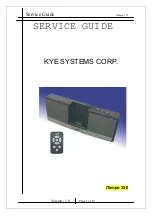
SPEAKER WIRE PATHS
In general, you should pay particular attention to the following areas:
• Avoid running speaker wires close to house electrical wiring for any
distance. If you have to run them parallel, make sure to space the
speaker wires at least two feet from the AC line. It is, however, okay
for speaker wires to cross paths with AC lines or go through the same
hole together with house wiring if they separate before and after.
• Make sure that the entire path between speakers and amplifier is
clear and not obstructed by a floor or ceiling joist or masonry wall
which you won’t be able to drill through.
• Remember that the other end of the wires has to come out some-
where to connect with the amplifier. Confirm ahead of time that
you can drill an outlet hole easily and in an un-obtrusive spot.
PAINTING THE SPEAKERS
If you like the designer white finish which has been applied to your
Russound Ceiling Speakers, skip to the section “cutting holes”. But if
you want your speakers to completely blend in with a colored wall or
accent the surface, now is the time to paint your Russound speakers’
outer frames and perforated grilles.
The speaker’s outer surfaces are primed to accept ordinary latex wall
paint or aerosol spray paint. Because the surface behind the perforated
grille should remain black, you will need to mask this area off before
you begin painting or use the included template cover.
1. Remove the speaker grilles. From the back of the speaker, push the
clamp (dog-ear) towards the grill to loosen it so you can pull it off.
2. Attach masking tape to the cardboard masking template which has
been included with your speakers.
3. Press the template onto each speaker’s surface to cover the woofer
and tweeter.
4. Paint the outer speaker frame and grille separately. A roller with a
short or medium nap will work much better than a brush. If you’re
using spray paint, make sure that you achieve the same coverage on
both grille and frame.
5. After the paint has thoroughly dried, remove the template and/or
masking tape.
There’s no need to replace the grill at this time since you will need
access to the inner speaker surface during installation.
CUTTING HOLES FOR THE SPEAKERS
Wallboard is an easy surface in which to make a relatively neat hole.
Make sure you don’t make it any bigger than the template. In the fol-
lowing steps, you’re going to locate a section of ceiling or wall between
two joists/studs, mark the outer boundaries of the hole, drill a small hole
in the center to confirm your location and then cut the main hole.
1. Determine the location of your joists/studs so that the speaker can be
approximately centered between them. There are several ways to go
about this:
- Tap on the wall and listen to the resulting “THUMP”. When it’s deep-
er, you’re between studs. When it’s sharper and more flat-sounding,
you’re close to a stud.
- Use a stud-finder, a simple little magnetic device which works by
locating the lines of nails hammered into the stud.
- Identify studs by the position of electrical outlets or switches. There
will be a stud either directly to the left or right of a an electrical fix-
ture. This gives you a point of measurement since studs are either 18
or 16 inches apart in newer houses, 12 inches apart on older homes.
2. When you’re reasonably sure of where the joists or 2x4 studs are (and
are TOTALLY sure that there isn’t an electrical cable, water pipe or
heating duct in that vicinity of wall), position one of the cardboard
mounting templates and draw an outline with a pencil. If you don’t
trust your eye, use a level to make sure the hole will be perfectly
round.
3. Drill a 1-inch hole in the center of the pencil outline which you have
just drawn.
4. Obtain a length of stiff wire such as an un-bent coat hanger. Bend it
so that the last 12 inches is at a right angle to the rest.
5. Insert the angled part into the 1-inch hole you just drilled and probe
to left and right to confirm that a joist or stud is not close on either
side.
- If there is a close joist/stud on one side, just re-position the card-
board template a few inches in the opposite direction and re-draw
your pencil outline, keeping the 1-inch hole within the pencil out-
line’s inner boundaries.
6. Score the outline of the template with a utility knife to prevent chip-
ping or wall paper from tearing. Then use a keyhole/dry-wall saw to
cut in the opening.
- If you’re dealing with lath and plaster or thick paneling, you need to
use a different technique. Drill 1-inch holes at the corners of the
pencil outline. Then use a fine-toothed key-hole saw or even a hack-
saw blade with VERY slow strokes to saw through and remove the
inner surface.
4
Summary of Contents for SP503.1
Page 11: ...NOTES 11 ...






























